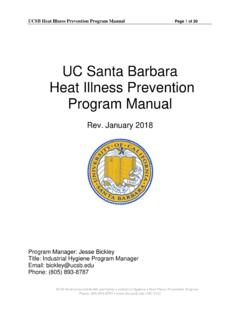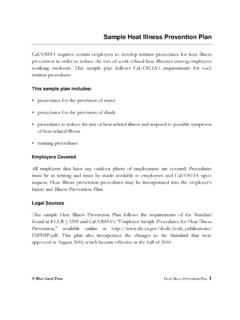Transcription of Heat-Related Illness in Athletes - University of Chicago
1 1384 heat Illness has received substantial public attention in theUnited States after the recent deaths of collegiate and profes-sional Athletes in the National Collegiate Athletic Association(NCAA), National Football League, and Major LeagueBaseball from heat stroke. heat stroke is currently the thirdleading cause of death in Athletes behind cardiac disordersand head and neck ,30 Early recognition and prompttreatment are keys to the prevention of morbidity and mor-tality from heat Illness . Because exertional heat stroke isentirely preventable, this article focuses on prevention tacticsthat may help reduce the incidence of catastrophic heat strokeevents. These prevention strategies include proper acclimati-zation to the heat ; proper fluid replacement before, during, andafter exertion; wearing proper clothing during certain envi-ronmental conditions; and early recognition of heat Illness viadirect monitoring of Athletes by other players, coaches, andmedical is unclear why some Athletes progress to heat illnesswhile others with similar risk factors are spared whenexposed to the same environmental stressors.
2 Studies exam-ining high-risk individuals for early signs and symptoms ofheat Illness are ongoing. The ability to predict who is mostsusceptible to heat injury and thus offer appropriate earlyintervention treatments would be a major breakthrough inprevention of this OF Heat-Related ILLNESSThe graded continuum of heat Illness progresses from verymild to more serious disease to a life-threatening conditionknown as heat stroke (Table 1). There is no evidence thatmild heat Illness ( heat edema, heat rash, heat cramps, orheat syncope) will progress to severe disease if , the development of heat exhaustion is signifi-cant. Without treatment, heat exhaustion has the potentialto progress to heat EdemaVery mild forms of heat Illness occur in the form of heatedema and heat rash (also known as prickly heat or mil-iaria rubra).
3 heat edema appears as dependent soft tissueswelling, usually in the lower extremities, in a person lack-ing acclimatization. Peripheral vasodilation to produceheat loss leads to pooling of interstitial fluid in the distalextremities. This leads to an increase in vascular hydro-static pressure and resultant third spacing of intravascu-lar fluid into the surrounding soft tissue. The condition ismore commonly seen in older adults who enter a tropicalclimate without proper RashMiliaria rubra (ie, heat rash or prickly heat ) presents asa pinpoint papular erythematous, often intensely pru-ritic, eruption in areas covered with clothing. It com-monly presents in the waist or over highly sweaty areassuch as the trunk or groin.
4 Profuse sweating saturatesHeat- related Illness in AthletesAllyson S. Howe, MD, and Barry P. Boden, MDFrom the Malcolm Grow Medical Center Family Medicine Residency, Andrews Air Force Base,Maryland, and The Orthopaedic Center, Rockville, MarylandHeat stroke in Athletes is entirely preventable. Exertional heat Illness is generally the result of increased heat production and impaireddissipation of heat . It should be treated aggressively to avoid life-threatening complications. The continuum of heat Illness includes milddisease ( heat edema, heat rash, heat cramps, heat syncope), heat exhaustion, and the most severe form, potentially life-threateningheat stroke. heat exhaustion typically presents with dizziness, malaise, nausea, and vomiting, or excessive fatigue with accompanyingmild temperature elevations.
5 The condition can progress to heat stroke without treatment. heat stroke is the most severe form of heatillness and is characterized by core temperature >104 F with mental status changes. Recognition of an athlete with heat Illness in itsearly stages and initiation of treatment will prevent morbidity and mortality from heat stroke. Risk factors for heat Illness include dehy-dration, obesity, concurrent febrile Illness , alcohol consumption, extremes of age, sickle cell trait, and supplement use. Proper edu-cation of coaches and Athletes , identification of high-risk Athletes , concentration on preventative hydration, acclimatizationtechniques, and appropriate monitoring of Athletes for Heat-Related events are important ways to prevent heat stroke.
6 Treatment ofheat Illness focuses on rapid cooling. heat Illness is commonly seen by sideline medical staff, especially during the late spring andsummer months when temperature and humidity are high. This review presents a comprehensive list of heat illnesses with a focus onsideline treatments and prevention of heat Illness for the team medical : heat stroke; heat exhaustion; dehydration; prevention*Address correspondence to Allyson S. Howe, Family Medicine Clinic,1075 W. Perimeter Road, Andrews AFB, MD 20762 (e-mail: potential conflict of interest American Journal of Sports Medicine, Vol. 35, No. 8 DOI: 2007 American Orthopaedic Society for Sports MedicineTeam Physician s CornerVol. 35, No. 8, 2007 Heat-Related Illness in Athletes1385the skin surface and clogs the sweat ducts.)
7 Obstructionof the ducts results in leakage of eccrine sweat into theepidermis. Secondary infection with staphylococcus mayproduce prolonged SyncopeHeat syncope occurs with orthostatic hypotension result-ing from peripheral vasodilation (physiologic response toheat production) and venous pooling. Prolonged standingafter significant exertion and rapid change in body posi-tion after exertion, such as from sitting to standing, maylead to heat ,40 Athletes with heat syncope tendto recover their mental status quickly once supine, as bloodflow to the central nervous system CrampsOne of the earliest indications of heat Illness presents in theform of muscle spasm or muscle cramps. This typicallyresults after excessive heat exposure that leads to profusesweating coupled with inadequate fluid and electrolyteintake; the muscles may begin to spasm, causing painfulcontractions.
8 Often this results in the inability to continueactivity for a short time. Sodium loss is thought to play a sig-nificant role in exacerbating heat formagnesium, potassium, or calcium abnormalities contribut-ing to heat cramps is not yet cramps may occuralone or concurrently with symptoms of heat with heat cramps have not been shown to be pre-disposed to serious heat Illness such as heat ExhaustionHeat exhaustion may be the initial presentation of heat ill-ness. Typically a condition in which core body temperatureis between 37 C ( F) and 40 C (104 F), heat exhaus-tion often presents with malaise, fatigue, and sweating is classically noted as well as nausea,vomiting, headache, fainting, weakness, and cold orclammy skin.
9 Critical to the diagnosis of heat exhaustionis normal mentation and stable neurologic StrokeHeat exhaustion can progress to heat stroke when unrec-ognized or untreated. heat stroke is characterized byboth an elevated core temperature of 40 C or greater andcentral nervous system (CNS) disturbance (irritability,ataxia, confusion, coma). In the setting of suspected heatillness with a temperature below 40 C and mental statuschanges, heat stroke should still be considered a likelydiagnosis as some cooling could have taken place en routeto medical treatment. Treatment for heat stroke shouldbe initiated while evaluating for other conditions. Withthis potentially fatal condition, prompt recognition andtreatment offer the best chance of and Exertional heat StrokeTwo types of heat stroke have been described: classic, inwhich the environment plays a major role in an individ-ual s ability to dissipate heat , and exertional, in whichintrinsic heat production is the primary cause for hyper-thermia.
10 Necessary with both conditions is the dysfunctionof the thermoregulatory system to dissipate heat createdby or absorbed by the body. The idea of intrinsic heat pro-duction with exertional heat stroke is supported by theobservations that most classic heat stroke events arelinked to environmental heat waves, while exertional-typeheat strokes can and have occurred in all types of definition of classic versus exertional heat strokeoffers no utility in management of the patient with heatstroke. Classic heat stroke has been defined in some textsby anhidrotic skin. It should be noted that exertional heatstroke victims often demonstrate profuse sweating. Thepresence or absence of sweating is an inconsequentialdiagnostic criterion for heat stroke.










